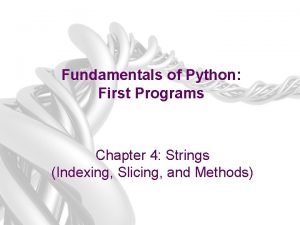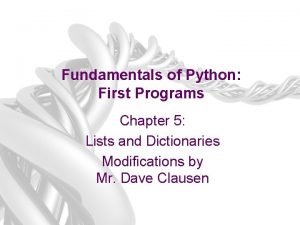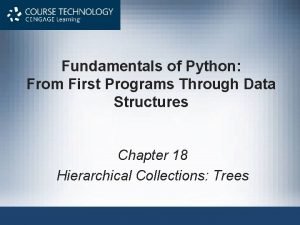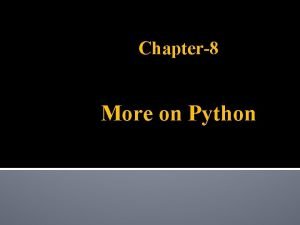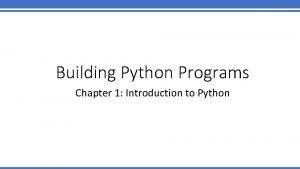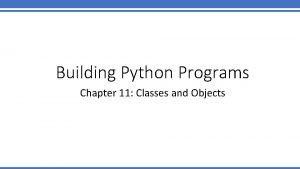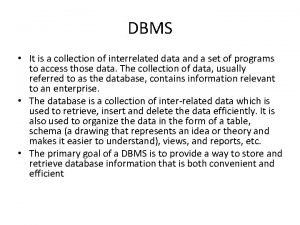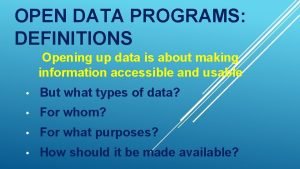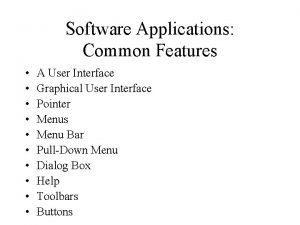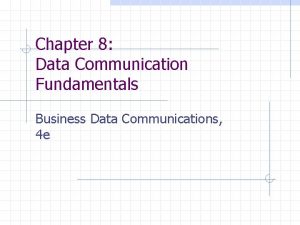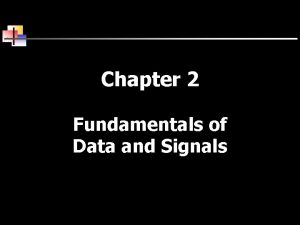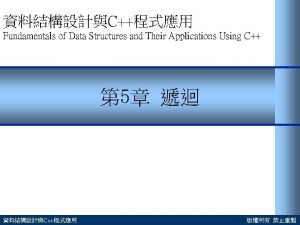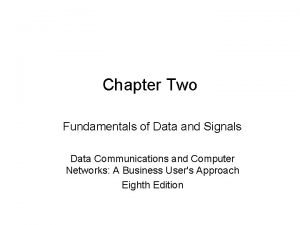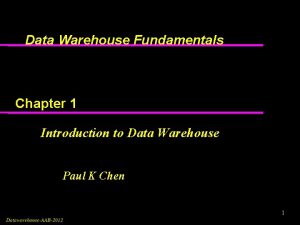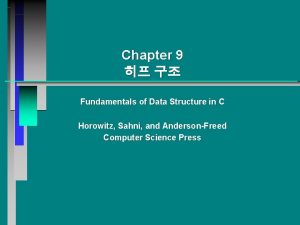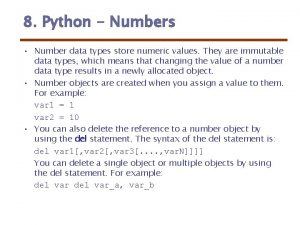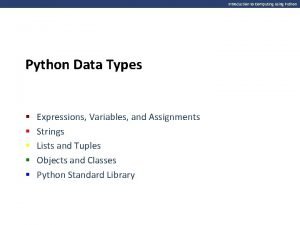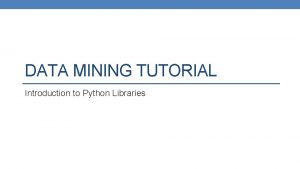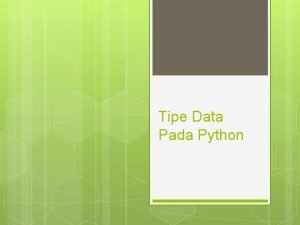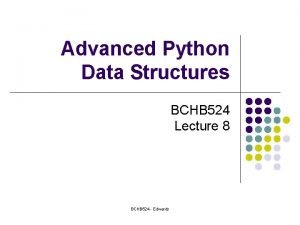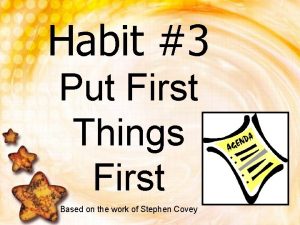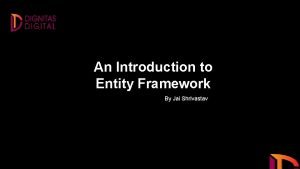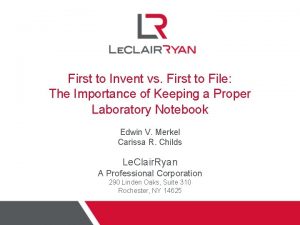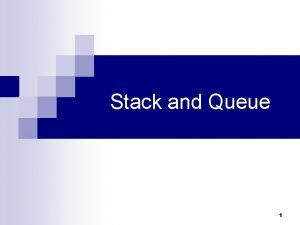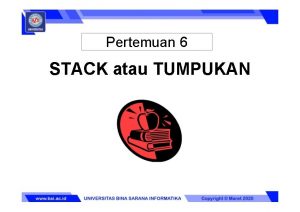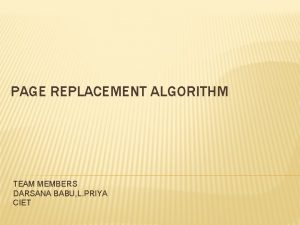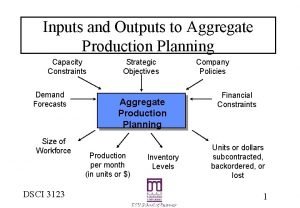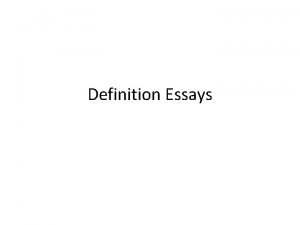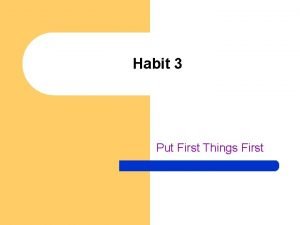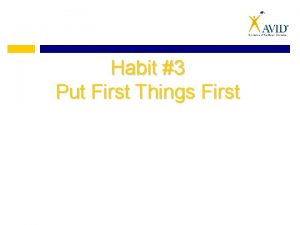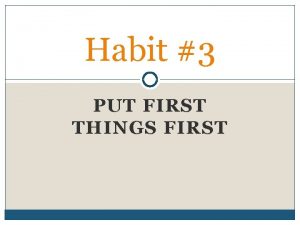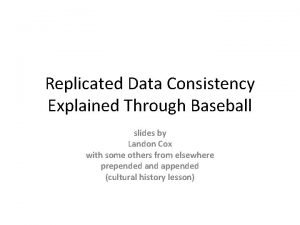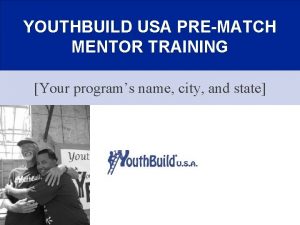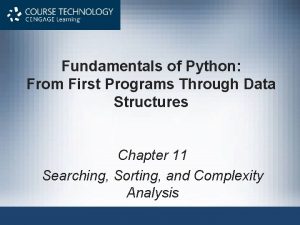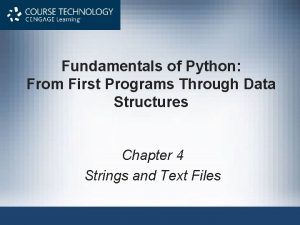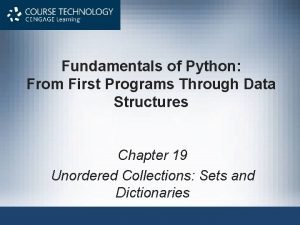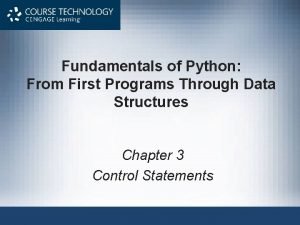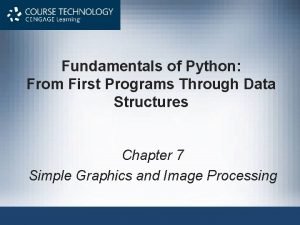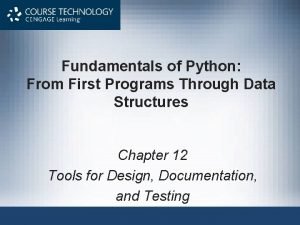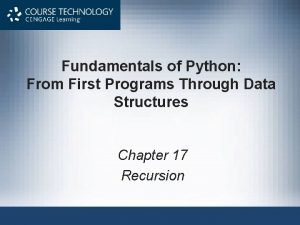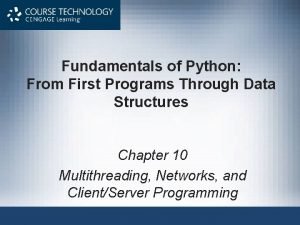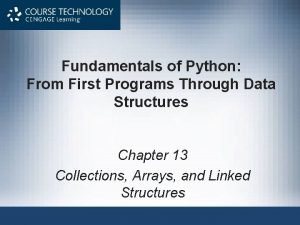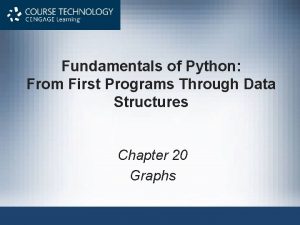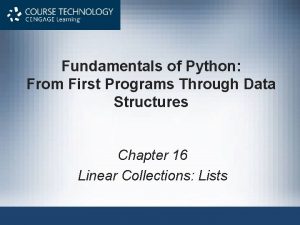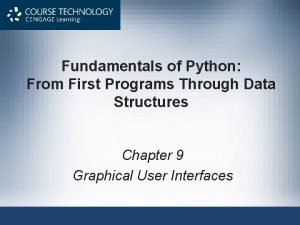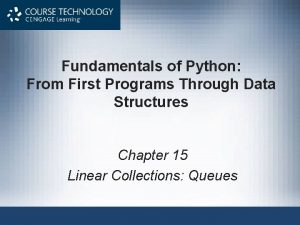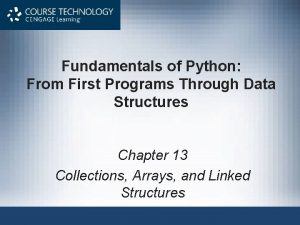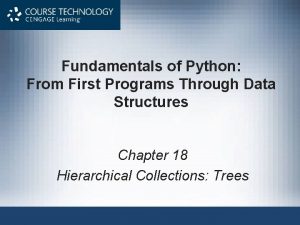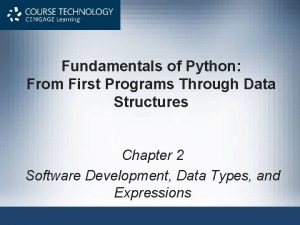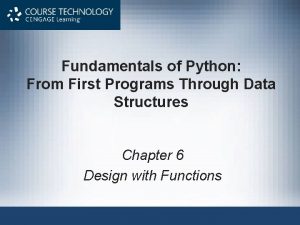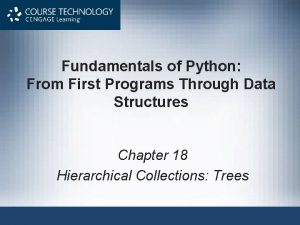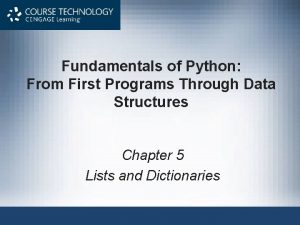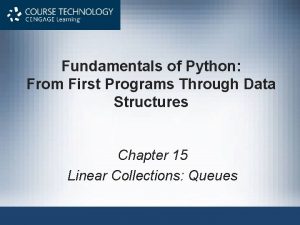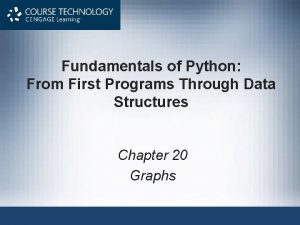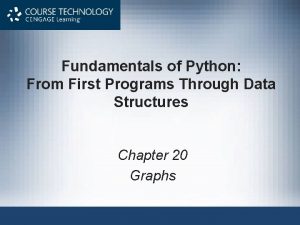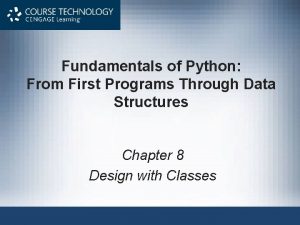Fundamentals of Python From First Programs Through Data


























































- Slides: 58

Fundamentals of Python: From First Programs Through Data Structures Chapter 8 Design with Classes

Objectives After completing this chapter, you will be able to: • Determine the attributes and behavior of a class of objects required by a program • List the methods, including their parameters and return types, that realize the behavior of a class of objects • Choose the appropriate data structures to represent the attributes of a class of objects • Define a constructor, instance variables, and methods for a class of objects Fundamentals of Python: From First Programs Through Data Structures 2

Objectives (continued) • Recognize the need for a class variable and define it • Define a method that returns the string representation of an object • Define methods for object equality and comparisons • Exploit inheritance and polymorphism when developing classes • Transfer objects to and from files Fundamentals of Python: From First Programs Through Data Structures 3

Getting Inside Objects and Classes • Programmers who use objects and classes know: – Interface that can be used with a class – State of an object – How to instantiate a class to obtain an object • Objects are abstractions – Package their state and methods in a single entity that can be referenced with a name • Class definition is like a blueprint for each of the objects of that class Fundamentals of Python: From First Programs Through Data Structures 4

A First Example: The Student Class • A course-management application needs to represent information about students in a course Fundamentals of Python: From First Programs Through Data Structures 5

The Student Class (continued) Fundamentals of Python: From First Programs Through Data Structures 6

The Student Class (continued) • Syntax of a simple class definition: class header – Class name is a Python identifier • Typically capitalized • Python classes are organized in a tree-like class hierarchy – At the top, or root, of this tree is the object class – Some terminology: subclass, parent class Fundamentals of Python: From First Programs Through Data Structures 7

The Student Class (continued) Fundamentals of Python: From First Programs Through Data Structures 8

Docstrings • Docstrings can appear at three levels: – Module – Just after class header • To describe its purpose – After each method header • Serve same role as they do for function definitions • help(Student) prints the documentation for the class and all of its methods Fundamentals of Python: From First Programs Through Data Structures 9

Method Definitions • Method definitions are indented below class header • Syntax of method definitions similar to functions – Can have required and/or default arguments, return values, create/use temporary variables – Returns None when no return statement is used • Each method definition must include a first parameter named self • Example: s. get. Score(4) – Binds the parameter self in the method get. Score to the Student object referenced by the variable s Fundamentals of Python: From First Programs Through Data Structures 10

The __init__ Method and Instance Variables • Most classes include the __init__ method – Class’s constructor – Runs automatically when user instantiates the class • Example: s = Student("Juan", 5) • Instance variables represent object attributes – Serve as storage for object state – Scope is the entire class definition Fundamentals of Python: From First Programs Through Data Structures 11

The __str__ Method • Classes usually include an __str__ method – Builds and returns a string representation of an object’s state • When str function is called with an object, that object’s __str__ method is automatically invoked • Perhaps the most important use of __str__ is in debugging Fundamentals of Python: From First Programs Through Data Structures 12

Accessors and Mutators • Methods that allow a user to observe but not change the state of an object are called accessors • Methods that allow a user to modify an object’s state are called mutators • Tip: if there’s no need to modify an attribute (e. g. , a student’s name), do not include a method to do that Fundamentals of Python: From First Programs Through Data Structures 13

The Lifetime of Objects • The lifetime of an object’s instance variables is the lifetime of that object • An object becomes a candidate for the graveyard when it can no longer be referenced Student object still exists, but interpreter will recycle its storage during garbage collection Fundamentals of Python: From First Programs Through Data Structures 14

Rules of Thumb for Defining a Simple Class • Before writing a line of code, think about the behavior and attributes of the objects of new class • Choose an appropriate class name and develop a short list of the methods available to users • Write a short script that appears to use the new class in an appropriate way • Choose appropriate data structures for attributes • Fill in class template with __init__ and __str__ • Complete and test remaining methods incrementally • Document your code Fundamentals of Python: From First Programs Through Data Structures 15

Case Study: Playing the Game of Craps • Request: – Write a program that allows the user to play and study the game of craps • Analysis: define Player and Die classes – User interface: prompt for number of games to play Fundamentals of Python: From First Programs Through Data Structures 16

Case Study: Design Fundamentals of Python: From First Programs Through Data Structures 17

Case Study: Implementation (Coding) Fundamentals of Python: From First Programs Through Data Structures 18

Case Study: Implementation (Coding) (continued) … Fundamentals of Python: From First Programs Through Data Structures 19

Data-Modeling Examples • As you have seen, objects and classes are useful for modeling objects in the real world • In this section, we explore several other examples Fundamentals of Python: From First Programs Through Data Structures 20

Rational Numbers • Rational number consists of two integer parts, a numerator and a denominator – Examples: 1/2, 2/3, etc. • Python has no built-in type for rational numbers – We will build a new class named Rational Operators need to be overloaded Fundamentals of Python: From First Programs Through Data Structures 21

Rational Number Arithmetic and Operator Overloading • Object on which the method is called corresponds to the left operand – For example, the code x + y is actually shorthand for the code x. __add__(y) Fundamentals of Python: From First Programs Through Data Structures 22

Rational Number Arithmetic and Operator Overloading (continued) • To overload an arithmetic operator, you define a new method using the appropriate method name • Code for each method applies a rule of rational number arithmetic Fundamentals of Python: From First Programs Through Data Structures 23

Rational Number Arithmetic and Operator Overloading (continued) • Operator overloading is another example of an abstraction mechanism – We can use operators with single, standard meanings even though the underlying operations vary from data type to data type Fundamentals of Python: From First Programs Through Data Structures 24

Comparisons and the __cmp__ Method • __cmp__ is called whenever you use the comparison operators: ==, !=, <, >, <=, and >= • Returns 0 if operands are equal, -1 if left operand is < right one, 1 if left operand > right one Fundamentals of Python: From First Programs Through Data Structures 25

Equality and the __eq__ Method • Not all objects are comparable using < or >, but any two objects can be compared for == or != two. Thirds < "hi there" should generate an error two. Thirds != "hi there" should return True • Include __eq__ in any class where a comparison for equality uses a criterion other than object identity Fundamentals of Python: From First Programs Through Data Structures 26

Savings Accounts and Class Variables Fundamentals of Python: From First Programs Through Data Structures 27

Savings Accounts and Class Variables (continued) Fundamentals of Python: From First Programs Through Data Structures 28

Savings Accounts and Class Variables (continued) Fundamentals of Python: From First Programs Through Data Structures 29

Putting the Accounts into a Bank Fundamentals of Python: From First Programs Through Data Structures 30

Putting the Accounts into a Bank (continued) Fundamentals of Python: From First Programs Through Data Structures 31

Putting the Accounts into a Bank (continued) Fundamentals of Python: From First Programs Through Data Structures 32

Using c. Pickle for Permanent Storage of Objects • c. Pickle allows programmer to save and load objects using a process called pickling – Python takes care of all of the conversion details Fundamentals of Python: From First Programs Through Data Structures 33

Input of Objects and the try-except Statement Fundamentals of Python: From First Programs Through Data Structures 34

Playing Cards • Use of the Card class: • Because the attributes are only accessed and never modified, we do not include any methods other than __str__ for string representation • A card is little more than a container of two data values Fundamentals of Python: From First Programs Through Data Structures 35

Playing Cards (continued) Fundamentals of Python: From First Programs Through Data Structures 36

Playing Cards (continued) • Unlike an individual card, a deck has significant behavior that can be specified in an interface • One can shuffle the deck, deal a card, and determine the number of cards left in it Fundamentals of Python: From First Programs Through Data Structures 37

Playing Cards (continued) • During instantiation, all 52 unique cards are created and inserted into a deck’s internal list Fundamentals of Python: From First Programs Through Data Structures 38

Case Study: An ATM • Develop a simple ATM program that uses the Bank and Savings. Account classes • Request: – Write a program that simulates a simple ATM • Analysis: – Figure 8. 1 shows sample terminal-based interface – Class diagram in Figure 8. 2 shows the relationships among the classes • Name of each class appears in a box • Edges connecting the boxes show the relationships – Use model/view pattern to structure the code Fundamentals of Python: From First Programs Through Data Structures 39

Case Study: An ATM (continued) Fundamentals of Python: From First Programs Through Data Structures 40

Case Study: An ATM (continued) • Design Fundamentals of Python: From First Programs Through Data Structures 41

Structuring Classes with Inheritance and Polymorphism • Most object-oriented languages require the programmer to master the following techniques: – Data encapsulation: Restricting manipulation of an object’s state by external users to a set of method calls – Inheritance: Allowing a class to automatically reuse/ and extend code of similar but more general classes – Polymorphism: Allowing several different classes to use the same general method names • Python’s syntax doesn’t enforce data encapsulation • Inheritance and polymorphism are built into Python Fundamentals of Python: From First Programs Through Data Structures 42

Inheritance Hierarchies and Modeling Fundamentals of Python: From First Programs Through Data Structures 43

Inheritance Hierarchies and Modeling (continued) • In Python, all classes automatically extend the builtin object class • It is possible to extend any existing class: • Example: – Physical. Object would extend object – Living. Thing would extend Physical. Object • Inheritance hierarchies provide an abstraction mechanism that allows the programmer to avoid reinventing the wheel or writing redundant code Fundamentals of Python: From First Programs Through Data Structures 44

Example: A Restricted Savings Account A Restricted. Savings. Account permits up to three withdrawals • To call a method in the parent class from within a method with the same name in a subclass: Fundamentals of Python: From First Programs Through Data Structures 45

Example: The Dealer and a Player in the Game of Blackjack Fundamentals of Python: From First Programs Through Data Structures 46

Example: The Dealer and a Player in the Game of Blackjack (continued) • An object belonging to Blackjack class sets up the game and manages the interactions with user Fundamentals of Python: From First Programs Through Data Structures 47

Example: The Dealer and a Player in the Game of Blackjack (continued) Fundamentals of Python: From First Programs Through Data Structures 48

Example: The Dealer and a Player in the Game of Blackjack (continued) Fundamentals of Python: From First Programs Through Data Structures 49

Example: The Dealer and a Player in the Game of Blackjack (continued) Fundamentals of Python: From First Programs Through Data Structures 50

Example: The Dealer and a Player in the Game of Blackjack (continued) Fundamentals of Python: From First Programs Through Data Structures 51

Polymorphic Methods • We subclass when two classes share a substantial amount of abstract behavior – The classes have similar sets of methods/operations – A subclass usually adds something extra • The two classes may have the same interface – One or more methods in subclass override the definitions of the same methods in the superclass to provide specialized versions of the abstract behavior • Polymorphic methods (e. g. , the __str__ method) Fundamentals of Python: From First Programs Through Data Structures 52

Abstract Classes • An abstract class includes data and methods common to its subclasses, but is never instantiated Fundamentals of Python: From First Programs Through Data Structures 53

The Costs and Benefits of Object. Oriented Programming • Imperative programming – Code consists of I/O, assignment, and control (selection/iteration) statements – Does not scale well • Improvement: Embedding sequences of imperative code in function definitions or subprograms – Procedural programming • Functional programming views a program as a set of cooperating functions – No assignment statements Fundamentals of Python: From First Programs Through Data Structures 54

The Costs and Benefits of Object. Oriented Programming (continued) • Functional programming does not conveniently model situations where data must change state • Object-oriented programming attempts to control the complexity of a program while still modeling data that change their state – Divides up data into units called objects – Well-designed objects decrease likelihood that system will break when changes are made within a component – Can be overused and abused Fundamentals of Python: From First Programs Through Data Structures 55

Summary • A simple class definition consists of a header and a set of method definitions • In addition to methods, a class can also include instance variables • Constructor or __init__ method is called when a class is instantiated • A method contains a header and a body • An instance variable is introduced and referenced like any other variable, but is always prefixed with self Fundamentals of Python: From First Programs Through Data Structures 56

Summary (continued) • Some standard operators can be overloaded for use with new classes of objects • When a program can no longer reference an object, it is considered dead and its storage is recycled by the garbage collector • A class variable is a name for a value that all instances of a class share in common • Pickling is the process of converting an object to a form that can be saved to permanent file storage • try-except statement is used to catch and handle exceptions Fundamentals of Python: From First Programs Through Data Structures 57

Summary (continued) • Most important features of OO programming: encapsulation, inheritance, and polymorphism – Encapsulation restricts access to an object’s data to users of the methods of its class – Inheritance allows one class to pick up the attributes and behavior of another class for free – Polymorphism allows methods in several different classes to have the same headers • A data model is a set of classes that are responsible for managing the data of a program Fundamentals of Python: From First Programs Through Data Structures 58
 Python subscript operator
Python subscript operator Fundamentals of python: first programs
Fundamentals of python: first programs Fundamentals of python data structures
Fundamentals of python data structures Cpmcd full form
Cpmcd full form Python about
Python about Building python programs
Building python programs Building python programs
Building python programs Java programs perform i/o through ……….. *
Java programs perform i/o through ……….. * First time homebuyer riverside
First time homebuyer riverside Fundamentals of first aid
Fundamentals of first aid By one man sin
By one man sin Furcation involvement classification
Furcation involvement classification Advantage of through and through sawing
Advantage of through and through sawing Summary of the poem night of the scorpion by nissim ezekiel
Summary of the poem night of the scorpion by nissim ezekiel Is collection of interrelated data.
Is collection of interrelated data. Programs that organize analyze and graph numerical data
Programs that organize analyze and graph numerical data Open data programs
Open data programs Algorithms + data structures = programs
Algorithms + data structures = programs Programs that organize analyze and graph numerical data
Programs that organize analyze and graph numerical data Fundamentals of data communication
Fundamentals of data communication Fundamentals of data and signals
Fundamentals of data and signals Fundamentals of data structures in c
Fundamentals of data structures in c Fundamentals of data and signals
Fundamentals of data and signals Data domain fundamentals
Data domain fundamentals Data warehouse fundamentals
Data warehouse fundamentals Fundamentals of data structure in c
Fundamentals of data structure in c Data modeling fundamentals
Data modeling fundamentals Python numbers.number
Python numbers.number Python algebraic data types
Python algebraic data types Data mining with python tutorial
Data mining with python tutorial Python tipe sistem
Python tipe sistem Advanced data structures in python
Advanced data structures in python Graph data structure python
Graph data structure python Maturity continuum examples
Maturity continuum examples Breadth vs depth search
Breadth vs depth search Sdl first vs code first
Sdl first vs code first Put first things first activities
Put first things first activities Put first things first
Put first things first Entity framework 7 release date
Entity framework 7 release date First to file vs first to invent
First to file vs first to invent First in first out
First in first out Instruksi yang diberikan untuk menghapus data stack adalah
Instruksi yang diberikan untuk menghapus data stack adalah First in first out
First in first out First come first serve
First come first serve Put first things first definition
Put first things first definition Gantt chart fcfs
Gantt chart fcfs See do get model
See do get model Habit number 3
Habit number 3 Put first things first video
Put first things first video Put first things first activities
Put first things first activities First aid merit badge first aid kit
First aid merit badge first aid kit First aid in the first grade
First aid in the first grade 7 habits promise
7 habits promise Finding answers through data collection
Finding answers through data collection Bitcoin
Bitcoin Prematch programs
Prematch programs Employee engagement programs examples
Employee engagement programs examples Three types of early childhood programs
Three types of early childhood programs Types of early childhood programs chapter 2
Types of early childhood programs chapter 2
